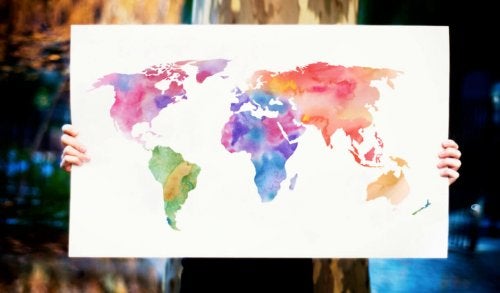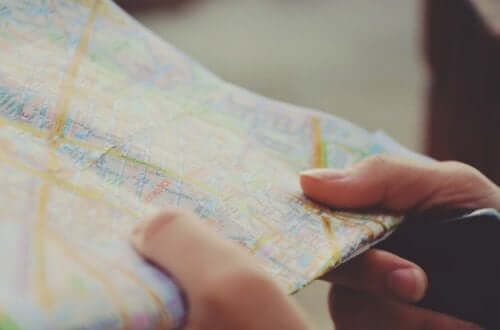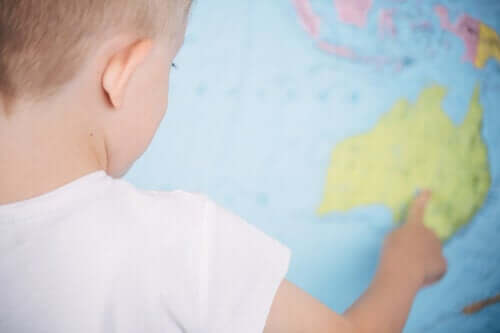Teaching Geography to Children: A World to Discover

Geography studies the relationship between human beings and the physical environment. Therefore, teaching geography to children as soon as possible is essential. But how can this be done and what benefits are there?
The concept of geography
In itself, geography is the science that studies the shape of the earth. In fact, it’s related to the study of climate, soil, water, and plant formations on a surface. And taking into account the origin of the term geography (from the Greek geographer), it attempts to describe the elements of the earth’s surface as well as their distribution and arrangement.
Geography isn’t an isolated science; Rather, it’s deeply linked to astronomy, geology, natural science, history, and political economy. This fact establishes a deep relationship with the population entities and the different cultures that exist in the world. In addition, it affects the communication networks established by man in the physical environment.
The benefits of teaching geography to children
Here are some benefits of geography for children:
- It forces them to think about the spatial location of the various places present in the world.
- It helps to create awareness regarding the importance of caring for the environment.
- Geography teaches children that there are cultures other than their own; which are present in other parts of the world. Therefore, you have to learn to respect them.
- In view of the problems present in the environment (global warming, pollution, economic crisis, water shortage, etc.), teaching geography to children is essential in order to teach them the importance of solving these problems together; as they also affect them.
- It provides valuable data on the physical, social, and biological aspects that can help humans prepare for a natural disaster.
- It teaches them how to make better use of the natural resources present in a given place, a fact that can favorably influence the economic development of various nations.
- Teaching geography engraves in the children the concepts of homeland and nation, which are deeply related to the land that they inhabit.
- It helps them understand the history of various civilizations in the world.
All human actions, in addition to being carried out at a specific time, also require their development in a particular place.
From this fact, we understand why various ancient civilizations settled near rivers and favorable climatic regions; which allowed them to develop in an economic sense. Now, how do you make learning geography attractive to children?

How to teach geography to children
Currently, various methods are used when teaching geography to children. Some of them will be mentioned below:
- Using maps, although it’s a material that’s not too appealing to children, as it’s difficult for them to imagine the relationship between a place and the one drawn on a map. However, it helps them to have a mental image related to a place present on the earth’s surface.
- The use of images related to the places to be taught where the activities and characteristic landscapes of a region can be appreciated. This way, a greater realism in teaching is obtained.
- Although it’s said that the best way to learn geography is by traveling, this is often impossible when it comes to costs and time. However, in view of the advancement of technology, the internet or simulation technologies can be used when teaching geography for children.
- Use comparative tables where the differences or contrasts between regions are established.
- Establish the advantages and disadvantages of a country with respect to its interrelation with the rest of the world, which is deeply linked to where it is on the earth’s surface.
- Make drawings of the surfaces where different countries in the world are established. This allows these images to be etched in the child’s mind by making an outline of them.
What’s sought with these methods is that children discover and value natural landscapes; many of which man turned into their habitat at the cost of degrading environmental conditions. Therefore, we need to raise awareness in future generations in regard to caring for the environment.
Technological advances and the relationship with geography for children
There’s no doubt that technological advances have been an essential tool; they allow us to know the characteristics of a place in order to know how degraded it is and thus take the necessary measures to improve the conditions in which we currently live.
Only in this way can people collaborate with the care of the environment by knowing what the consequences of not doing so are. In fact, they can learn from the mistakes made by various civilizations or peoples. Not taking care of the habitat where they settled constitutes one of the fundamental elements of the present and the future.

Solving the problem of global warming and pollution
The minimal efforts that many people make in caring for the environment shouldn’t be taken for granted; since all humans with the little they can do are contributing to the general solution of the problem present in the world in relation to pollution and global warming.
But this can only be achieved if people are taught from a young age; both in children and adolescents; the importance of learning geography in order to resolve the natural conflicts that humanity faces in daily life.
All cited sources were thoroughly reviewed by our team to ensure their quality, reliability, currency, and validity. The bibliography of this article was considered reliable and of academic or scientific accuracy.
- Bernáldez, F. G. El paisaje natural. https://fungobe.org/wp-content/uploads/2022/04/1988_elpaisajenatural.pdf
- Cabero Almenara, J., & Llorente Cejudo, M. D. C. (2005). Las TIC y la educación ambiental. Revista Latinoamericana de Tecnología Educativa, 4 (2), 9-26. https://idus.us.es/bitstream/handle/11441/17359/file_1.pdf?sequence=1
- de Sánchez, A. G. P., & Pizzinato, L. A. R. (2006). La salida de campo: una manera de enseñar y aprender geografía. Geoenseñanza, 11(2), 229-234. https://www.redalyc.org/pdf/360/36012425008.pdf
- Fernández-Soria, J. M. (2016). Patria y nación en los textos escolares. Significado y aprendizaje de España. REXE-Revista de Estudios y Experiencias en Educación, 11(22), 137-154. http://www.rexe.cl/ojournal/index.php/rexe/article/view/93/88
- Franyutti, M. A. L. (2019). La influencia de las civilizaciones antiguas en la educación actual. Logos Boletín Científico de la Escuela Preparatoria No. 2, 6(12), 12-13. https://repository.uaeh.edu.mx/revistas/index.php/prepa2/article/view/4252
- Freire, E. E. E. (2022). Construcción del pensamiento geográfico en los niños. Sociedad & Tecnología, 5(2), 394-405. http://institutojubones.edu.ec/ojs/index.php/societec/article/view/222
- García, O. (2006). El lenguaje cartográfico como instrumento para la enseñanza de una geografía crítica y para la educación ambiental. MJ Marrón, L. Sánchez y O. García (Coords.), Cultura Geográfica y Educación Ciudadana, 483-502.
- García Rozo, M., Villegas, M., & González, F. (2015). La noción del espacio en la primera infancia: Un análisis desde los dibujos infantiles. Paradígma, 36(2), 223-245. http://ve.scielo.org/scielo.php?script=sci_arttext&pid=S1011-22512015000200011
- Liebel, M., & Saadi, I. (2012). La participación infantil ante el desafío de la diversidad cultural. Desacatos, (39), 123-140. https://www.scielo.org.mx/scielo.php?script=sci_arttext&pid=S1607-050X2012000200009
- Martínez Medina, R., & García-Morís, R. (2014). El concepto paisaje en los curricula de Educación Infantil de las Comunidades Autónomas Españolas. https://ruc.udc.es/dspace/handle/2183/15549